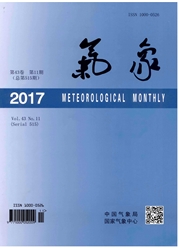

 中文摘要:
中文摘要:
由于从等熵位涡分析引申出来的平流层干侵入(以下简称干侵入)概念造成了当前天气预报思路中一些混乱和违背天气学常识的看法,文中回顾了天气预报原理从着眼气压变化到着眼涡度变化的发展历史和位涡问题的缘起。进而根据位涡的定义、数学表达式、物理意义,并结合实例的计算结果指出,位涡的大小主要取决于位温的垂直梯度;等熵面上的位涡分布形势实质是对流层顶高度的分布,因此可以间接反映极地气团、锋、高空槽和高空急流的形势。轨迹计算和数值预报都证明,低空的高位涡异常是地面气旋强烈加深和潜热反馈的结果,而不是干侵入的结果。指出位涡的守恒性不能替代斜压扰动发展的动力学机理;干侵入的错误概念来源于对位涡守恒性的绝对化和简单的推断,并犯了流体力学原理上混淆流线和轨迹两个不同概念的错误。
 英文摘要:
英文摘要:
In weather forecasting,there are some improper uses of the concept of stratospheric dry air intrusion into troposphere deduced from the isentropic potential vorticity(PV) analyses.This paper reviewed the history of weather forecast from pressure change to vorticity change,and discussed the origin of PV concept.Furthermore,based on the definition,mathematical expression,physical meaning,and computation of PV,this paper showed that PV value is mainly determined by the vertical gradient of potential temperature,and PV distribution reflects tropopause distribution,and thus indirectly reflects the distribution of polar air mass,front,upper-level trough and jet stream.The trajectories and model simulation both show that the PV anomaly in the lower atmosphere is resulting from the strong deepening of surface cyclone and the feedback of latent heat,instead from dry intrusion.This paper also pointed out that the law of PV conservation cannot be used to replace the dynamic mechanism of baroclinic disturbance development. The misuse of PV is from the heuristics of PV conservation and the confusion between trajectories and streamlines used in fluid mechanics.
 同期刊论文项目
同期刊论文项目
 同项目期刊论文
同项目期刊论文
 期刊信息
期刊信息
